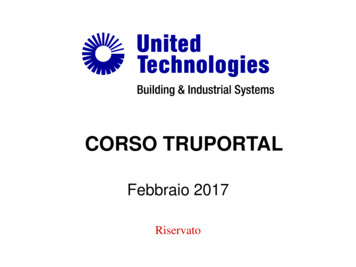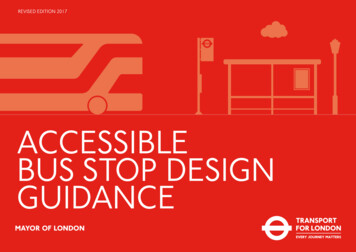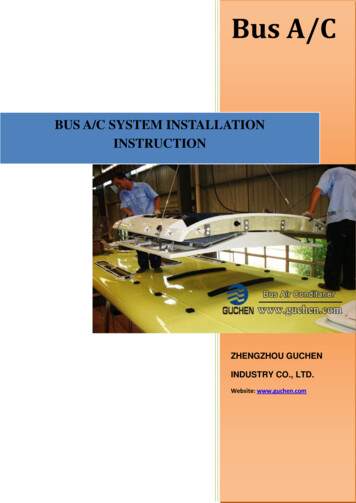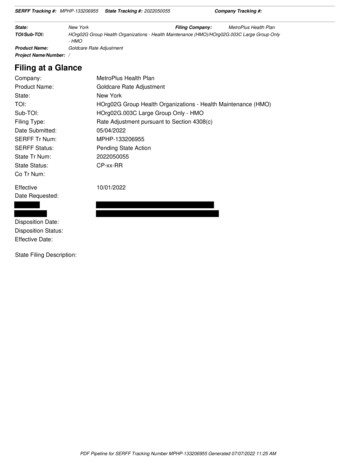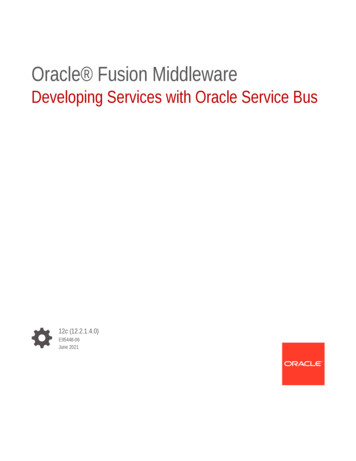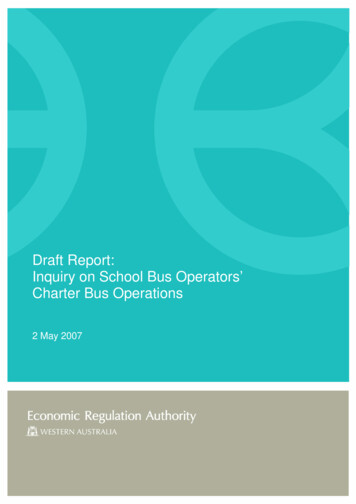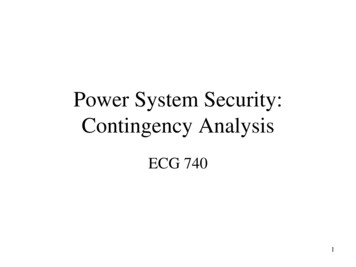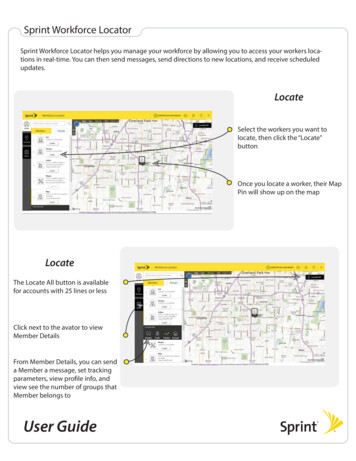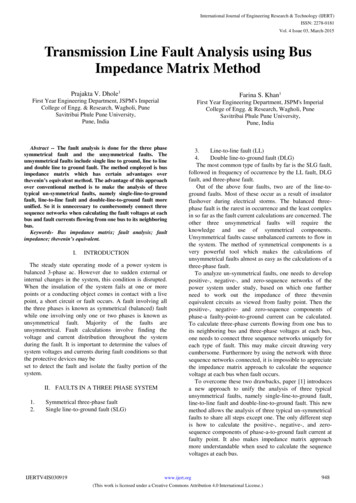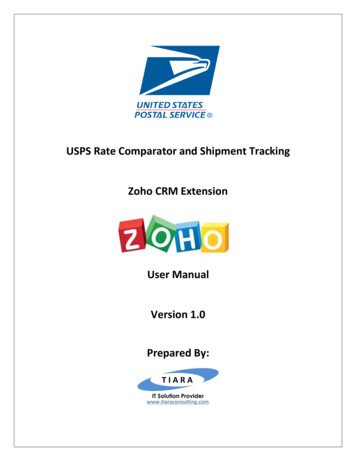Transcription
Vol-8 Issue-3 2022IJARIIE-ISSN(O)-2395-4396Bus Tracking System Using Mobile ApplicationMiss. Kute Sushma Vijay1, Miss. Chothave Reshma Vishnu2, Miss. Khandre Krutika Sanjay3,Miss. Gorde Priyanka Goraksha4, Prof. Umakant D. Butkar41,2,3,4,5Department of Computer Engineering, Sir Visvesvaraya Institute of Technology, Nashik, IndiaABSTRACTIn this fast life, everyone is in hurry to reach their destinations. In this case wait- ingfor the buses is not reliable. People who rely on the public transport their major concern is to know the real timelocation of the bus for which they are waiting for and the time it will take to reach their bus stop. This informationhelps people in making better travelling decisions. This paper gives the major challenges in the public transportsystem and discuss various approaches to intelligently manage it. Current position of the bus is acquired byintegrating GPS device on the bus and coordinates of the bus are sent by either GPRS service provided by GSMnetworks or SMS or RFID. GPS device is enabled on the tracking device and this information is sent to centralizedcontrol unit or directly at the bus stops using RF receivers. This system is further integrated with the historicalaverage speeds of each segment. This is done to improve the accuracy by including the factors like volume of traffic,crossings in each segment, day and time of day. People can track information using LEDs at bus stops, SMS, webapplication or Android application. GPS coordinates of the bus when sent to the centralized server where variousarrival time estimation algorithms are applied using historical speed pat- terns.Keyword : - Android; GPS, GSM, Position Grounded Services, Clustering, Artificial Neural Network.1. INTRODUCTIONBACKGROUNDVehicle tracking systems were first implemented for the shipping industry because people wanted to know whereeach vehicle was at any given time. These days, however, with technology growing at a fast pace, automated vehicletracking system is being used in a variety of ways to track and display vehicle locations in real-time.However, bus transportation service has very poor transportation information system nowadays. Bus users do notknow the exact arrival time for a bus, but only know the scheduled approximate arrival time. Bus transportationservice does not have a proper system to track all buses position and the actual arrival time in every bus stop. Theseproblems occur because current bus service system did not apply real time tracking technology to track on eachbuses on the road and also lack of a platform to update latest bus traffic information to bus users.In order to solve these problems and enhance current bus service system, real time bus tracking system has todevelop and implement. With real time bus tracking system, bus position data is connected real time and transmittedto a central server for processing and extracting transit information. The main technology used to develop thissystem is Global Positioning System (GPS). GPS technology able to receives the position of an object from spacebased satellite navigation system through a GPS receiver.For wireless data transmission, GSM and SMS technology are commonly used. The SMS technology through GSMnetwork and GSM modem provide a user with vehicle location information. Instead of using SMS, the bus trackingsystem uses the smart phone application to track and monitor a bus location obtained from the in-vehicle trackingdevice.The bus location is automatically placed on Google maps, which makes it easier for tracking a vehicle and providesusers with more accurate vehicle location information.The developed bus tracking system will be able to provide bus users a real time platform to check on updated bustraffic information, for example bus arrival or departure time. Besides, this system also reduces workload for busmanagement teamand provides an immediate platform to update latest and accurate bus traffic information to bus users.16557www.ijariie.com330
Vol-8 Issue-3 2022IJARIIE-ISSN(O)-2395-4396Figure 1.1: Bus Tracking System ArchitectureANDROIDOverviewAndroid is a mobile operating system (OS) currently developed by Google, based on the Linux kernel and designedprimarily for touchscreen mobile devices such as smart- phones and tablets. Android’s user interface is mainly basedon direct manipulation, using touch gestures that loosely correspond to real-world actions, such as swiping, tap- pingand pinching, to manipulate on-screen objects, along with a virtual keyboard for text input. In addition totouchscreen devices, Google has further developed Android TV for televisions, Android Auto for cars, and AndroidWear for wrist watches, each with a specialized user interface. Variants of Android are also used on notebooks,game consoles, digital cameras, and other electronics. Now we have phones which can even access GPS, GPRS, WiFi, NFC and lot of other cool and advanced features which you cannot even imagine. So in this Mobile world of thiscomplication, android is one of those operating system platforms which made it easy for manufacturers to design topclass phones.Stored and copied to a stream where the actual data is transferred. Due to its native characteristic, it runs in thebackground and waits for a possible transfer operation. They are called right after the related button is pressed.Services retrieve values from static class called Final-Values.java through intent’s extended data. They mainlyinclude Final Values .EXTRASGROUPOWNERADDRESSandAndroidOS.As it is widely known, android is a Linux-based operating system led by Google. It is mostly developed for mobiledevices to bring simplicity, functionality and efficiency to the market. Android is an open source project and it has alarge number of developers writing applications. Developers write applications primarily in Java (Stephen Shankland, 2007) and applications can be downloaded mostly through official online store called Google Play. Currentlythere is 600,000 applications available on Google Play and so far 20 billion applications downloaded from this store(engaged, 2012).Android runs on Linux with libraries and libraries written in C. Dan Merrill, Android Engineer in Google, explainedthat Android is not a specification, or a distri- bution in the traditional Linux sense. It’s not a collection ofreplaceable components. Android is a chunk of software that you port to a device.Android uses the Dalvik Virtual Machine to run Dalvik Executable code trans- lated from Java byte code. Allstandard API are defined in terms of classes, interfaces, methods and objects. In terms of hardware platform, ARMarchitecture is main plat- form for Android. However, there is also support for x86 architecture.ArchitectureArchitecture Android runs on Linux under Dalvik VM. Dalvik has a just-in-time compiler where the byte codestored in memory is compiled to a machine code. Byte code can be defined as ‘intermediate level’. JIT compiler16557www.ijariie.com331
Vol-8 Issue-3 2022IJARIIE-ISSN(O)-2395-4396reads the byte code in many sections and compiles dynamically in order to run the program faster. Java performschecks on dependent portions of the code and thus the code is compiled only before it is executed. When it iscompiled once, it is cached and set to be ready for later uses.Figure 1.2: Android ArchitectureAndroid Studio and Android SDKStudio is the official IDE for Android app development, based on IntelliJ IDEA. On top of IntelliJ’s powerful codeeditor and developer tools, Android Studio offers even more features that enhance your productivity when buildingAndroid apps, such as:A flexible Gradle-based build system. Build variants and multiple APK file generation. Codetemplates to help you build common app features. A rich layout editor with support for drag and drop theme editing.Lint tools to catch performance, usability, version compatibility, and other problems Code shrinking with ProGuardand resource shrinking with Gradle. Built-in support for Google Cloud Platform, making it easy to integrate GoogleCloud Messaging and App Engine Android provides a custom plug-in for Android development called AndroidDevelopment Tool (ADT). It is designed to build Android applications. It lets the developer to establish newAndroid projects, build and debug applications, and export APKs.GPS Tracking unitA GPS tracking unit is a device, normally carried by a moving vehicle or person, that uses the Global PositioningSystem to determine and track its precise location, and hence that of its carrier, at intervals. The recorded locationdata can be stored within the tracking unit, or it may be transmitted to a central location data base, or Internetconnected computer, using a cellular (GPRS or SMS), radio, or satellite modem embedded in the unit. This allowsthe asset’s location to be displayed against a map backdrop either in real time or when analyzing the track later,using GPS tracking software. Data tracking software is available for smartphones with GPS capabilityGPS ArchitectureA GPS tracker essentially contains a GPS module to receive the GPS signal and calculate the coordinates. For dataloggers it contains large memory to store the co- ordinates, data pushers additionally contains the GSM/GPRSmodem to transmit this information to a central computer either via SMS or via GPRS in form of IP packetsFundamentals: The GPS concept is based on time and the known position of specialized satellites. The satellitescarry very stable atomic clocks that are syn- chronized to each other and to ground clocks. Any drift from true timemaintained on the ground is corrected daily. Likewise, the satellite locations are known with great precision. GPSreceivers have clocks as well; however, they are not synchro- nized with true time, and are less stable. GPS16557www.ijariie.com332
Vol-8 Issue-3 2022IJARIIE-ISSN(O)-2395-4396satellites continuously transmit their current time and position. A GPS receiver monitors multiple satellites andsolves equations to determine the precise position of the receiver and its deviationfrom true time. At a minimum, four satellites must be in view of the receiver for it to compute four unknownquantities (three position coordinates and clock deviation from satellite time).Mobile Phones with GPS Capability: Due in part to regulations encouraging mo- bile phone tracking, includingE911, the majority of GPS receivers are built into mobile telephones, with varying degrees of coverage and useraccessibility. Com- mercial navigation software is available for most 21st- century smartphones as well as someJava-enabled phones that allow them to use an internal or external GPS receiver (in the latter case, connecting viaserial or Bluetooth). Some phones using assisted GPS (A-GPS) function poorly when out of range of their carrier’scell towers. Others can navigate worldwide with satellite GPS signals as well as a dedicated portable GPS receiverdoes, upgrading their operation to A-GPS mode when in range. Still others have a hybrid positioning system that canuse other signals when GPS signals are inadequate.Mobile Messaging: Mobile messaging plays an essential role in LBS. Messaging, especially SMS, has been used incombination with various LBS applications, such as location-based mobile advertising. SMS is still the maintechnology carrying mobile advertising / marketing campaigns to mobile phones. A classic example of LBSapplications using SMS is the delivery of mobile coupons or discounts to mobile subscribers who are near toadvertising restaurants, cafes, movie theatres. The Singaporean mobile operator Mobile One carried out such aninitiative in 2007 that involved many local marketers, what was reported to be a huge success in terms of subscriberacceptance.Figure 1.3: Architecture of GPSMOTIVATIONMany cities have found that GPS tracking system not only improve the efficiency of city bus operation, but alsoencourage commuters to take the advantage of city bus system. Many city bus systems have discovered that GPStracking system allows monitoring the location and arrival time of their bus actually increase the number of peopleusing city buses for routine communing. The application is a user friendly one that anyone can access for free ofcost. The basic idea for this project was to guide the bus travelers with the routes, all the possible stops that come ontheir way to the destination and moreover, display maps and track their locations and show the estimate remainingtime required to reach. The aim is to overcome all the drawbacks faced in all the previous applications and generatefast and accurate results.2. LITERATURE SURVEYThe design of the navigation system was driven by a set of premises that distinguish it from other navigationsolutions.The service should be deployable on short term, and not in a far future.Deployment cost for the service provider should be efficient.Usage cost should be low considering currently common communication costs.Service should be easily adaptable and extendable to a fast changing reality. Next to deployability under currentconditions, another concern had a major influ-16557www.ijariie.com333
Vol-8 Issue-3 2022IJARIIE-ISSN(O)-2395-4396ence in system design: user friendliness. The system should require as little interaction from the user as possible andlittle change of his habits. Furthermore, all interfaces be- tween user and navigation system should be carefullydesigned so that users unfamiliar with the system or with technology in general feel comfortable using it. Finally,being userfriendly also implies using technologies that most users are already familiar with, so that they do not haveto acquire any new device or learn to handle one. A navigation sys- tem complying to these design requirementsenhances the experience of users of a PTN in a cost effective way. Visitors and sporadic users are target user groups,as the system is especially helpful for people unfamiliar with the PTN. But also normal users would profit, beingguided to destinations out of their current and known parts of the transport network, for example visiting a place forthe first time in an area they do not usually use. In this way, the navigation system enhances the urban mobilityexperience and makes using the PTN more attractive to people unfamiliar with it. As with any application, it’simportant to consider the target audience. In this case, I can divide transit riders into new or infrequent riders, whoaren’t overly familiar with the local transit system, and frequent riders, who are familiar with it and use it every day.New or infrequent riders are less familiar with available routes and often need more trip-planning guid- ance,whereas frequent riders typically already know which sequence of stops and routes is the fastest to reach theirdestination, so they just want to know when the next bus is coming. The application presented in this article istargeted primarily at this secondgroup of frequent transit users. While static schedules and timetables are an important base for rider information, thereality is that transit vehicles do not always run on time. Traffic congestion, weather, accidents, and passengerincidents: there is any number of reasons why a transit vehicle might not meet its schedule. As such, many recenttransit traveller information system improvements have focused on providing real-time arrival information.EXISTING SYSTEMThere are many existing platforms and applications that are used to assist com- muters plan their travel uses mobiledata for the connectivity and communication and GPS to get the real-time location of the bus (or other means oftransport) relative to the commuter. There are solutions that offer a limited accuracy in metropolitan cities.However, these solutions are not available to the other cities and also, they rely on historical data to provideinformation. The Intelligent Transport System (ITS)s based solutions can be studied to overcome these pitfall, wouldhelp the commuter to effectively utilize the public transport which includes lower waiting time. There are manyimplementations of Intelligent Transport System all around the world, each solu- tion designed to address a specificdemographic region. There are existing solutions like tram TRACKER by Yarra Technologies in Melbourne,Australia and Google Maps is always there to cater the needs of the metropolitan computers.PROBLEM STATEMENTPossessing own transportation has become more common nowadays. The number of vehicles on the road keep onincreasing and most of us are eager to own personal vehicle as we can go anywhere without limitation.Undoubtedly, the existence of bus has reduced road traffic and taking bus is a good starting to inculcate the carpooling value. Besides, it provides a low-cost trans- portation which means to the low-income family for traveling toanother destination. However, things always don’t come perfect.The main drawback of traveling with bus is the inconsistent arrival time which may due to unforeseencircumstances. Even when we know the bus schedule well, there are number of reasons that bus as may not arrive asexpected.Traffic congestionsHeavy downpourBus breakdownsIt is particularly annoying when a person has urgent appointment, but we are late due to the time-consuming of bustrip.PROPOSED SYSTEM16557www.ijariie.com334
Vol-8 Issue-3 2022IJARIIE-ISSN(O)-2395-4396The real time tracking of bus can be done and this information is then given to remote user who wants to know thereal time bus information. Our system provides the relevant information regardingReal time location: Here the current location of the bus will be displayed.Route details: The system will display the route details with stops name.Driver’s Contact Number: The system will display the driver’s name with contact details.Average waiting time and expected time to reach: The system will display the ETA(estimated time of arrival) on theGoogle maps between two stops.Real time traffic to diverse route in case of heavy congestion: The system will display the traffic details for thedriver in case of congestion.OBJECTIVESThe objective of bus tracking system is,The mobile phone industry is one of the fastest and most dynamic business sec- tors today. The need tocommunicate efficiently and instantaneously is always an undying necessity. The market sector and the evergrowing and demanding consumers always want to have more, and they want it better than ever. Having a mobilephone for us makes life easier.Communication is always a part of daily life, and we cannot avoid it. The invention of mobile phone has gonetremendous leaps in innovation and new applications. Originally, it was intended to be a telephone that can becarried wirelessly at greater distances.Advances in communications, upgrades in radio frequency and developments on the internet had given mobilephones more sophisticated but easy to use in appli- cations.The main goal of the proposed work is to improve the Bus system by adding the necessary additional features intothe application, like accurate bus timings, correct bus numbers and moreover adding a GPS tracker into it.3. SOFTWARE REQUIREMENT SPECIFICATIONFUNCTIONAL REQUIREMENTSFunctional requirements refer to the functionalities that must apply to a system.The functional requirements of bus tracking system are stated below.The system must be able to show information to user in real time.The system must be able to process the position data received from bus positioning module, calculate the estimatedtime to user and display the position on maps.The system must be able to show estimated arrival time for every bus in every bus stop.The system must be able to allow user retrieve information from mobile device and computer.The system must be able to show the traffic information on maps.NON-FUNCTIONAL REQUIREMENTSThe system should provide the accurate estimated bus arrival time to user.The system should reduce the paper work done by bus management team.The system should be able to increase the efficiency and performance of bus service.The system should reduce work done by bus management team by automated calculation of estimated bus arrivaltime and showing real time bus position to user.The system should allow user to access information in anywhere with anytimeUSER REQUIREMENTSThere are two main target users for the proposed system, bus user (student/staff) and bus management team. Therequirement from different user is stated below.16557www.ijariie.com335
Vol-8 Issue-3 2022IJARIIE-ISSN(O)-2395-4396Bus user:Student/Staff is the main user of the proposed system because the main objective of bus tracking system is toprovide estimated bus arrival time for student.The student/staff must able to retrieve real time estimated bus arrival time for every bus stop. While waiting in busstop, student able to access bus tracking system with mobile device instead of using computer to access.This is the main purpose of bus tracking system in mobile application is developed. The system is provided real timebus tracking system with mapping feature, which mean student/staff able to view the bus position with a map.With this mapping technique, student able to know where is a bus position based on the map in real time.Bus Driver :Bus driver is the second important user of this system. Bus driver is able to update bus status accordingly in order toinform bus users about immediate situation.SYSTEM REQUIREMENTSSystem Processor: Pentium P4Mobile Processor: 1GHz or higherMotherboard: Genuine IntelMemory: 512 MB of RAM, 1GB recommended.Display:1024x 768 or higher-resolution display with 16 bits colors of android mobile phone.SOFTWARE REQUIREMENTSOperating system: Windows XP or higher.Technology Used: Android 4.1 or higherIDE: Android Studio 3.0.1Plug-in: ADT plug-in(Android Development Tool)Language: Android, JAVA.Actor:StudentFacultyDriverBus applicationUse-case:Get the bus locationGet the bus informationGet current locationSend locationUpdate locationPre-condition:GPS In bus should be working properly and should send the coordinates to the serverPost-condition:Mobile application should receive location of bus from serverUSE CASE DIAGRAM16557www.ijariie.com336
Vol-8 Issue-3 2022IJARIIE-ISSN(O)-2395-4396Figure 3.1: Use case diagram4. DESIGN ANALYSISSYSTEM ARCHITECTUREThis chapter describes features, fragments, classes, architecture and the application itself by providing necessaryinformation of major components. First, overall information is given along with project’s components and classes.Subsequently, the architecture details of the application are discussed16557www.ijariie.com337
Vol-8 Issue-3 2022IJARIIE-ISSN(O)-2395-4396Figure 4.1: System architecture of bus trackingACTIVITY DIAGRAM16557www.ijariie.com338
Vol-8 Issue-3 2022IJARIIE-ISSN(O)-2395-4396Figure 4.2: Data flow diagramDATA FLOW DIAGRAM16557www.ijariie.com339
Vol-8 Issue-3 2022IJARIIE-ISSN(O)-2395-4396Figure 4.3: Activity diagram of bus tracking5. IMPLEMENTATION16557www.ijariie.com340
Vol-8 Issue-3 2022IJARIIE-ISSN(O)-2395-4396PLATFORM SELECTIONAndroid StudioIt is the official integrated development environment (IDE) for Google’s Android operating system, built onJetBrains’ IntelliJ IDEA software and designed specifically for Android development. It is available for downloadon Windows, macOS and Linux based operating systems. It is a replacement for the Eclipse Android DevelopmentTools (ADT) as primary IDE for native Android application development.The following features are providedin the current stable version:Gradle-based build supportAndroid-specific refactoring and quick fixesLint tools to catch performance, usability, version compatibility and other prob- lemsProGuard integration and app-signing capabilitiesTemplate-based wizards to create common Android designs and componentsA rich layout editor that allows users to drag-and-drop UI components, option to preview layouts on multiple screenconfigurations. Support for building Android Wear apps Built-in support for Google Cloud Platform, enablingintegration with Firebase Cloud Messaging (Earlier ’Google Cloud Messaging’) and Google App Engine. AndroidVirtual Device (Emulator) to run and debug apps in the Android studio. Android Studio supports all the sameprogramming languages of IntelliJ, and PyCharm e.g. Python, and Kotlin and Android Studio 3.0 supports ”Java 7language features and a subset of Java 8 language features that vary by platform version.” External projects backport some Java 9 featuresPROGRAMMING LANGUAGE GIST JAVAAndroid applications are developed using the Java languageSome of the Java’s important core features are:1.It’s easy to learn and understand2.It’s designed to be platform-independent and secure, using virtual machines3.It’s object-orientedAndroid relies heavily on these Java fundamentals.The Android SDK includes many standard Java libraries (data structure libraries, math libraries, graphics libraries,networking libraries and everything else you could want) as well as special Android libraries that will help youdevelop awesome Android applications.6 RESULTSSCREENSHOTS16557www.ijariie.com341
Vol-8 Issue-3 42
Vol-8 Issue-3 43
Vol-8 Issue-3 44
Vol-8 Issue-3 2022IJARIIE-ISSN(O)-2395-43967. CONCLUSIONSGPS Based Bus tracking System is an Application that has its client side on theAndroid platform. Application is free of cost and easy to install on device. The accuracy of this system relies on theGPS coordinates generated using satellites while reliability of the system depends on the GPRS facility. The systemis effective where Internet is accessible. By including the concept of direction, the size of the database has reducedto half, thereby not exhausting the server and database with similar sets of data in different tables. The proposedsystem also predicts the average velocity of the bus using clustering and back propagation method. This increasesthe accuracy of the system as it also takes into account the traffic conditions during that day of week and time of theday.8. ACKNOWLEDGEMENTIt gives us great pleasure in presenting the project report on ‘ANALYSIS ON BUSTRACKING SYSTEM GPS ON SMARTPHONES’.The satisfaction that accompanies to successful completionof any task would be complete without mention of people whose ceaseless cooperation made it possible,whoseconstant guidance and encouragement crown all efforts with success.We would like to take this opportunity to thank my internal guide Mr.UmakantD.Butkar Sir,Head of Computer Engineering Department Mr.Sharad M. Rokade Sir and Principal .G.B.ShindeSir for giving us all the help and guidance we needed.We are also thankful to all the staff members of the ComputerEngineering Department, SVIT Chincholi, Nashik.We are really grateful to them for their kind support.We also thank our colleagues who have helped in successful completion of the firstproject stage.9. REFERENCES16557www.ijariie.com345
Vol-8 Issue-3 2022IJARIIE-ISSN(O)-2395-4396[1]Ana Aguiar, Francisco Maria Cruz Nunes., “Leveraging Electronic Ticketing to Pro- vide PersonalizedNavigation in a Public Transport Network.” IEEE Trans. Intell.Transp. Syst., vol. 13, no. 1, pp. 213–220, Mar. 2012[2]B. Ferris, K. Watkins, and A. Borning, “Location-aware tools for improving public transit usability,” IEEEPervasive Comput., vol. 9, no. 1,pp. 13–19, Jan.–Mar. 2010.[3]B.Caulfield and M.O’Mahony,“An examination of the public transport information requirements of users,”IEEE Trans. Intell. Transp. Syst., vol. 8, no. 1, pp. 21–30,Mar. Supporting pedestrian navigation in the real world,” IEEEPervasive Comput., vol. 6, no. 3, pp. 21–29, Jul.–Sep. ing multimodal travelers: Design and prototypicalimplementation of a personal travel companion,” IEEE Trans. on Intel- ligent Transportation Systems, vol. 8, no. 1,pp. 31–42, Mar 2007.[6]A. Repenning and A. Ioannidou, “Mobility Agents: Guiding and Tracking Pub- lic TransportationUsers,” Proc. Working Conf. Advanced Visual Interfaces, ACM Press, 2006, pp. 127–134.[7]T. H. Win, and Z. M. Aung, “Vehicle Navigation System Using GPS Receiver,” In Proc. of InternationalConference on Advances in Electrical and Electronics Engi- neering, 2011.[8]O. A.Elrhman, A. M. Ahmed, T. H. Mekki, and G. M. Taha, “Android Based Ve- hicle Tracking System,”In Proc. of Advances in Business Research International Conference, IEEE, Langkawi, Kedah, Malaysia, pp. 17-18November 2015[9]M. Ghareeb, A. Ghamlous, H. Hamdan, A. Bazzi, and S. A. Nabi, “Smart Bus: A Tracking System forSchool Buses,” In Proc. of International Conference on Sensors Networks Smart and Emerging Technologies, IEEE,Beirut, Lebanon, 12-14 Septem- ber 2017[10]M. A. A. Rashed, O. A. Oumar, and D. Singhm, “A Real Time GSM/GPS Based Tracking System Basedon GSM Mobile Phone,” In Proc. of International Conference on Future Generation Communication Technologies(FGCT 2013), IEEE, London, UK, March 2014.[11]M. Kahvecı, “Recent Advances in GNSS: Technical and Legal Aspects,” In Proc. of InternationalConference on Recent Advances in Space Technologies (RAST), IEEE, Istanbul, Turkey, June 2017.[12]A. Mulla, J. Baviskar, A. Baviskar, and A. Bhovad, “GPS Assisted Standard Po- sitioning Service forNavigation and Tracking: Review Implementation,” In Proc. of International Conference on Pervasive Computing(ICPC), IEEE, Pune, India, January 2015.16557www.ijariie.com346
Mobile Messaging: Mobile messaging plays an essential role in LBS. Messaging, especially SMS, has been used in combination with various LBS applications, such as location-based mobile advertising. SMS is still the main technology carrying mobile advertising / marketing campaigns to mobile phones. A classic example of LBS
